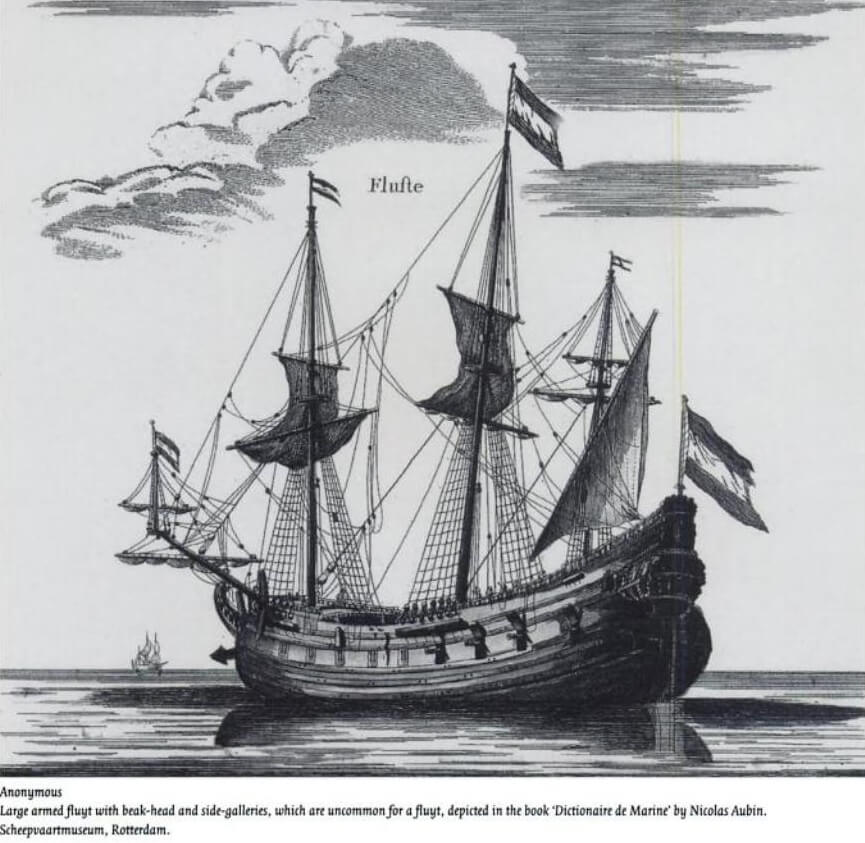⚓ DERFFLINGER ⚓
 fluyt vessel 1675
fluyt vessel 1675


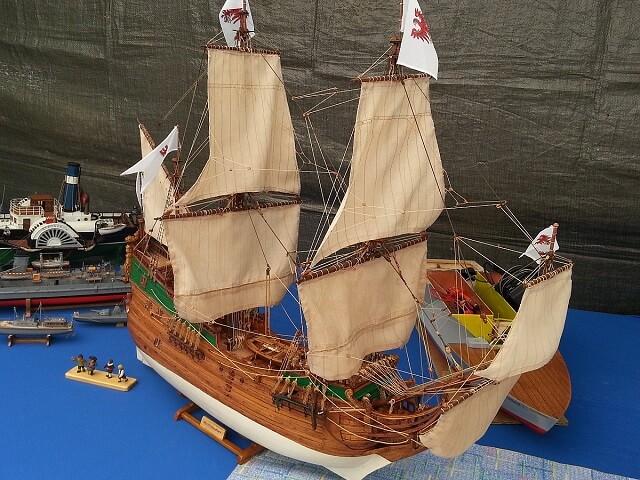
 A holland fleute, fluite, fluyt... és a Derfflinger
A holland fleute, fluite, fluyt... és a Derfflinger

A fleute a 17. században a hollandok által kifejlesztett kereskedelmi hajótípus. Kisebb merülésű, mint a galleon, a vízvonalánál azonban szélesebb. Az elő és főárbocon kereszt-, a tatárbocon egy latin- és egy keresztvitorlával rendelkezett. Ez a hajó alkotta a holland kereskedelmi flotta legjavát.
Ezen hajók mivel eleve a tengeri kereskedelmi hajózás céljából épültek egyszerűbb és könnyűbb szerkezettel rendelkeztek, nem igényeltek olyan mértékű anyagfelhasználást mint korabeli harcra vagy védelemre is alkalmas társai. Egye források szerint az 1680-as évekig csak fél tucat 4 fontos, valamint néhány 2 fontos ágyú szolgálta védelmüket. A hajót kezelő legénység számát is nagyjából 20 fő körül tervezték ami bizonyítja többek közt a hajó jó kezelhetőségét. Aránylag jó utazási sebességgel bírtak a hajótest keskenyebb kivitelezése miatt ( általában 3-szor hosszabbak voltak a szélességűknél). A hajógyárakban akkoriban modernnek számító építési technológiákat alkalmaztak melyek tovább csökkentették a költségeket, akár a korabeli ilyen jellegű vagy méretű hajók költségének a felére. Általában 110-120 láb hosszúságuak voltak, de aránylag kisebb méretük ellenére is kiváló teherbirásuk volt , akár 160-170 tonna rakomány hajózására is képesek voltak ami a korabeli hajók között kimagaslónak mondható.
Mindezen tények egy aránylag olcsón megépíthető hajót eredményeztek, komoly előnyt adva ezzel a holland kereskedőknek a hajók beszerzésében, számuk nővelésében. Érthető , hogy a holland kereskedelmi flotta nagyságát ez mind pozitivan befolyásolta így 1670 tájékán már 568,000 tonnát tett ki ami az akkori Európa hajózási kapacításának a felét jelentette. Mindez nagymértékben hozzájárult a holland királyság tengeri nagyhatalommá válásához.
Ezt a hajótipust feljegyzések szerint 1595-ben építették meg előszőr, egy Pieter Jansz Lioorne nevű kereskedő elképzelése alapján aki jelentős áru forgalmat bonyolított le Itáliával. E kereskedő többek közt 'történetesen' Hoorn város polgármestere valamint a hoorni Admiralitás tagja és tanácsosa. Befolyással bírt többek között Jan Gerbrantsz altengernagyra aki a flamand partvédelmi hajóhad parancsnoka volt. Lioorne ötlete az volt , hogy nincsen szükség a hajó megerősitett védelmére, a védelem miatt szükséges nehéz fegyverek(ágyúk) fölösleges szállítására , az ezzel járó széles hajótest építéséhez. Könnyű, kevés fegyverzetű, keskeny keresztmetszettel rendelkező hajótestű, tehát gyorsabb ám nagy teherbírású hajók építésére adott tanácsokat. Mindez a "flute, fluit, fluijt " tipusú vitorláshajó megszületéséhez, elterjedéséhez és népszerűségéhez vezetett.
Sajnos pontosan amiatt, hogy a kor egyik legelterjedtebb hajótipusa volt, nem tartották szükségszerűnek kellőképen és részletesen megőrökíteni az utókor számára kinézetüket, felépítésüket. Annyira mindennapinak és gyakorinak számítottak , hogy már ügyet sem vetettek reájuk amikor feltüntek a láthatáron. Számos ábrázoláson festményen lelhetőek fenn ezen hajók, azonban csak a háttér részeként. Igen ritka az olyan ábrázolás mely hűen tükrőzné szerkezetüket, tényleges kinézetüket. Egyetlen ismert modell sem maradt fennt az akkori időkből ( valószínű nem is épült)
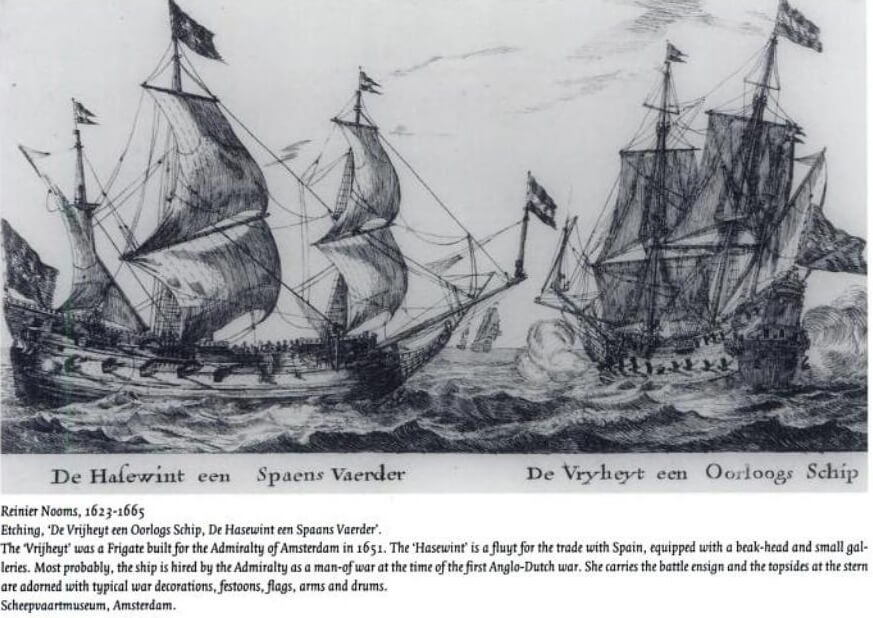
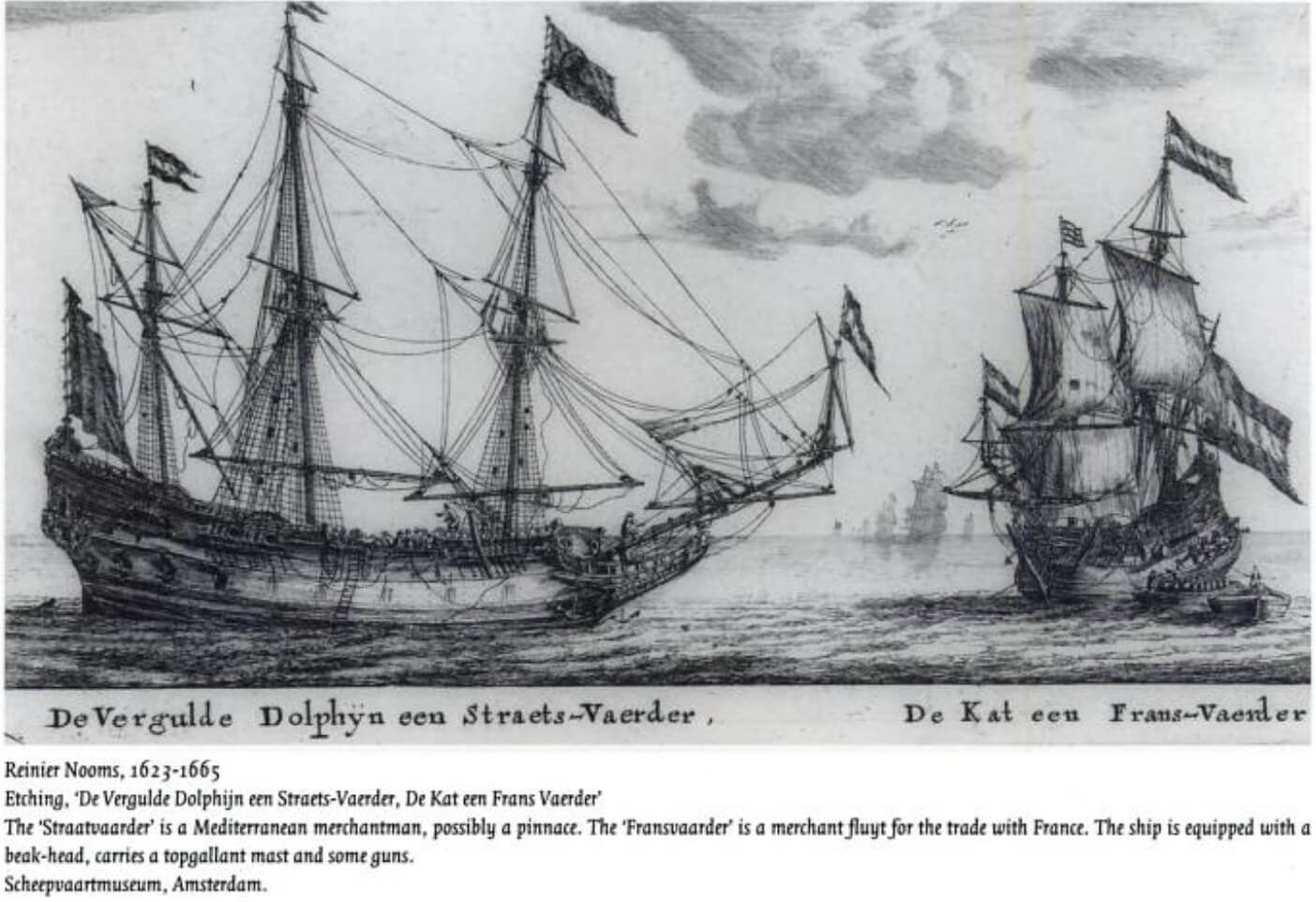
Valójában a Derrflinger hajóról is csak egy elnagyolt ábrázolás található meg egy korabeli 1684-ben Lieve Werschuier által készített festményen mely a hajót számos más ilyen típusú hajó mellet tünteti fel " A Nagy Kormányzó hajóhada" részeként. (Friedrich Wilhelm , németországi kormányzó hajóhada)
A hajót Georg von Derfflinger lovassági tábornok tiszteletére nvezték el, aki 1675-ben a brandenburgiak győzelmét bíztosította a Fehrbellin csatában a svéd csapatok ellen.
"Derfflinger" kétségtelenül két fedélzettel rendelkezett. A második fedélzeten az orr felé volt található, a konyha , a lőszer, az élelem és víz tárolására szolgáló területek . A far felé haladva, voltak a közepes méretű ágyúk és az iránytű. A fedélzet alatt a kő ballaszt helyezkedett el.
A fő fedélzeten a mellvédnél és a tatnál a negyedfedélzeten voltak a 4 fontos ágyúk.
A hajó fő tulajdonsága a rendkivüli teherbírása, 170 tonna rakomány hajózására volt képes.
Az interneten fellelhető és a "Derfflinger" hajóról szoló leírások hitelességűket tekintve nem meggyőzőek.E források szerint a hajót 1675-ben építették Németország kormányzója, Friedriech Wilhelm számára. A hajó eredeti neve "Wolkensaule" volt és csak 1684-ben nevezték el Georg von Derfflinger lovassági tábornok tiszteletére.
A 1686 - 1693 között a Derfflinger fluyt az úgynevezett "háromszög kereskedelem" útvonalán vitorlázott, Nyugat-Afrika, India, Európa partjai között. Abban az időben rumot és más árukat szállított, hogy Afrikában rabszolgákat vásároljanak ezek fejében, akiket aztán nyugat-indiai cukorra cseréltek le, amelyet Európába hoztak.
Többek között a 'Friedrich Wilhelm Zu Pferde' , valamint a "Hoffnung" volt a kísérete egyes utak alatt, Nyugat-Afrika partjai és a Shetland-szigetek felé.
A 17. század végén a DERFFLINGER fluyt a Kurfuerstentum Brandenburg flottába tartózott
A hajó más brandenburgi hajókkal együtt a spanyol örökösödési háborúban vett részt.
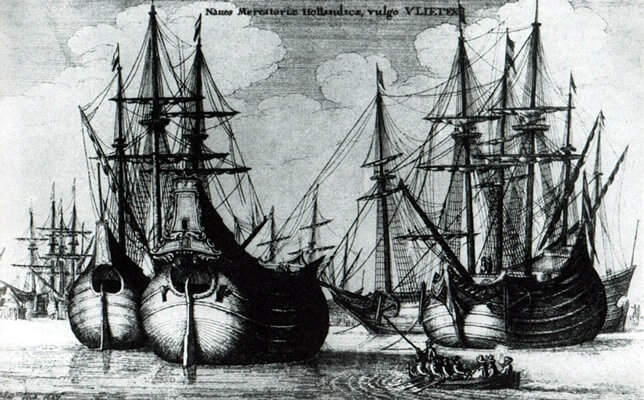 Dutch fluyts of the 17th century
Dutch fluyts of the 17th century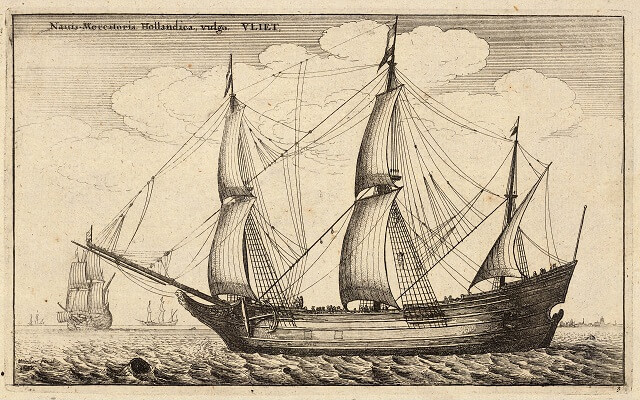
Dutch fluyt, 1677
 A little story...
A little story...

The Derfflinger fluyt
Derflinger is a Dutch fluyt vessel which was allegedly a part of the Urka fleet, designed especially for trading purposes.
The fluyts are different to ships used in Europe in the seventeenth century not only for their round shape with a lowered quarter deck but also for their pronounced round shaped-hull. Their dimensions were long and hulls of a very narrow cross-section compared to other square-sailed vessels.
The fluit is one of the few types of ships of which the history of its origin is recorded.
They were first produced in 1595 with square sails on their foremast and main mast and a lateen spanker on the mizzenmast. These vessels were fast but requiring only a small crew to operate them and had the advantage of being cheap to build. Until the year 1683, these vessels carried half a dozen 4 pound guns and a couple of 2 pound guns.
Pieter J. Lioorne-Hoorn (Holland) is credited with their design with the first feluccas built in Lubecca, Germany in 1618. The last one was built around 1780. The 'Friede' fluyt, as an example was built in Berlin in the dockyards of Berlin in 1682 – its length was 32 metres.
It is extraordinary that so little remain of such a popular vessel. On paintings and prints we regurarly see fluyts , but usually as an additional fill in. Rarely do we see fluyts pictured as the main subject of a painting or an etching. This is a handicap because there remain hardly any detailed pictures or prints ot hte fluyt. Also theres are no trustworthy technical models preserved (perhaps none were ever made). There are some quite satisfactory models exposed at the Amsterdam Maritime Museum and the Maritim Museum Rotterdam.
Furthermore a complete set of drawings of a fluyt, especially for the model builder , can be found in the German book " Risse von Schiffen des 16. un 17. Jahrhunderts". These drawings , made by Rolf Hoeckel, are based on a large painting: "The Fleet of the great Elector" by Lieve Verschuier, on which besides others the fluyt " Derfflinger" is shown. Neighter in hull shape nor in detail is this representation convincing.
'Derfflinger' certainly had two decks. Towards the bow was located the galley and areas for the storage of munitions, food and water. Below these areas was the stone ballast. Towards the stern, there were medium-size cannons and the compass. The forecastle generally contained four cannons, as did the stern area and quarter deck.
One of the main Derflinger's features was its lightweight design and immense capacity of cargo carrying, able to carry more than 170 tons of cargo. It could be also easily manoeuvred by even a small crew. The hull was reportedly large whereas the deck appeared slender.
Fluyt Derfflinger was built in 1675 for the Elector of Germany Friedrich Wilhelm. Prior to 1684, 'Derfflinger' was named 'Wolkensaule'.
It was purchased in Danzica in January 1681 by Benjamin Raule and was used during the war against Spain (May 1681) declared by Prince William Frederick. It was 110 feet long and 23 feet wide; it was armed with 3 – 16 cannons and crewed by about twenty men.
Later on the ship was named in honour of cavalry general Georg von Derfflinger, who 1675 won a Brandenburg victory in the battle of Fehrbellin against the Swedish. He is depicted on the stern of the ship wearing black breast plate armour, a navy uniform lined with red and leather trousers, a red scarf and a black hat containing red and white feathers. The background was blue and the whole picture was surrounded by deep red cloth and fringed with gold. The flag at the stern shows the Kurbrandenburg red eagle with hat, scepter, sword and breast shield.
The 'Friedrich Wilhelm Zu Pferde' had been its escort as well as the 'Hoffnung' during the trips up the Western Africa coast and up to the Shetland Islands.
Read more: (Euromodel-ship.com)
By the end of the 17th century the fluyt DERFFLINGER belonged to the fleet of Kurfuerstentum Brandenburg.
From 1686 – 1693 the fluyt sailed the Western Africa and India routes In the "triangle trade" of that time she transported rum and other stuff to Africa, to buy slaves, who were then exchanged in the West Indies for sugar, which was then brought to Europe. Later she and other Brandenburg ships were used in the War of the Spanish Succession.
About the dutch Fluyt (Vikipedia)
A fluyt (archaic/traditional: fluijt), fluit, felluca or flute is a Dutch type of sailing vessel originally designed as a dedicated cargo vessel. Originating from the Netherlands in the 16th century, the vessel was designed to facilitate transoceanic delivery with the maximum of space and crew efficiency. Unlike rivals, it was not built for conversion in wartime to a warship, so it was cheaper to build and carried twice the cargo, and could be handled by a smaller crew. Construction by specialized shipyards using new tools made it half the cost of rival ships. These factors combined to sharply lower the cost of transportation for Dutch merchants, giving them a major competitive advantage.
The fluyt was a significant factor in the 17th century rise of the Dutch seaborne empire.
In 1670 the Dutch merchant marine totalled 568,000 tons of shipping—about half the European total.
